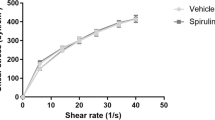Abstract
Purpose. Patches can cause a different grade of skin occlusion, depending on matrix composition and thickness, backing layer material. The aim of this work was to verify if in vitro water vapour permeability (WVP) values are predictive of transepidermal water loss (TEWL) and Fourier-transform infrared (FTIR) spectroscopy values measured in vivo after 24 h of methacrylic or acrylic monolayer patches application. The correlation between both in vivo methods has been evaluated.
Methods. The WVP, TEWL and FTIR measurements were performed by using four patches made of a methacrylic or an acrylic polymeric system (250 and 500 μm thickness on a polyurethane backing layer). A fifth patch was made of the methacrylic matrix on a polyvinyl chloride backing layer.
Results. A good correlation was found between TEWL values and IR water/lipid absorbance ratios. The in vitro WVP values are in a good correlation with the results of both in vivo methods: TEWL = −0.01WVP + 21.31 (R2 = 0.9312); FTIR water/lipid ratio = −0.01WVP + 27.15 (R2 = 0.9447).
Conclusions. The in vitro method proposed for measuring the WVP is predictive of the degree of occlusion resulting from the in vivo application of monolayer patches.
Similar content being viewed by others
REFERENCES
R. Aly, C. Shirley, B. Cunico, and H. I. Maibach. Effect of prolonged occlusion on the microbial flora, pH, carbon dioxide and transepidermal water loss on human skin. J. Invest. Dermatol. 71:378–381 (1978).
J. Faergemann, R. Aly, D. R. Wilson, and H. I. Maibach. Skin occlusion: effect on Pityrosporum orbiculare, skin PCO2, pH, transepidermal water loss, and water content. Arch. Dermatol. Res. 275:383–387 (1983).
A. A. Hartmann. Effect of occlusion on resident flora, skinmoisture and skin-pH. Arch. Dermatol. Res. 275:251–254 (1983).
E. Berardesca and H. I. Maibach. Skin occlusion: treatment or drug-like device? Skin Pharmacol. 1:207–215 (1988).
Y. H. Leow and H. I. Maibach. Effect of occlusion on skin. J. Dermatol. Treatment 8:139–142 (1997).
H. Zhai and H. I. Maibach. Skin occlusion and irritant and allergic contact dermatitis: an overview. Contact Dermatitis 44:201–206 (2001).
J. F. G. Hurkmans, H. E. Boddé, L. M. J. Van Driel, H. Van Doorne, and H. E. Junginger. Skin irritation caused by transdermal drug delivery system during long-term (5 days) application. Br. J. Dermatol. 112:461–467 (1985).
D. Bucks, R. H. Guy, and H. I. Maibach. Effect of occlusion. In Bronaugh R.L., Maibach H.I. (eds.), In vitro percutaneous absorption: Principles, fundamentals and applications. CRC Press, Boca Raton, Florida, 1991 pp. 85–114.
J. Welzel, K. P. Wilhelm, and H. H. Wolff. Skin permeability barrier and occlusion: no delay of repair in irritated human skin. Contact Dermatitis 35:163–168 (1996).
E. Proksch, K. R. Feingold, M. Mao-Qiang, and P. M. Elias. Barrier function regulates epidermal DNA synthesis. J. Clin. Invest. 87:1668–1673 (1991).
P. Treffel, P. Muret, P. Muret-D'Aniello, S. Coumes-Marquet, and P. Agache. Effect of occlusion on in vitro percutaneous absorption of two compounds with different physicochemical properties. Skin Pharmacol. 5:108–113 (1992).
D. Bucks and H. I. Maibach. Occlusion does not uniformely enhance penetration in vivo. In R.L. Bronaugh, H.I. Maibach (eds.) Percutaneos absorption: drug-cosmetics-mechanisms-methodology. 3rd edition, New York, Marcel Dekker Inc., 1999 pp. 81–105.
J. Pinnagoda, R. A. Tupker, T. Agner, and J. Serup. Guidelines for transepidermal water loss (TEWL) measurement. Contact Dermatitis 22:164–178 (1990).
R. O. Potts. In vivo measurements of water content of the stratum corneum using infrared spectroscopy: A review. Cosmetics and Toiletries 100:27–31 (1985).
British Pharmacopoeia. ed. 1993, Appendix XXJ.
P. Minghetti, F. Cilurzo, V. Liberti, and L. Montanari. Dermal therapeutic systems permeable to water vapour. Int. J. Pharm. 158:165–172 (1997).
V. Rogiers. Transepidermal water loss measurements in patch test assessment: the need for standardisation. Curr. Prob. Dermatol. 23:152–158 (1995).
H. Schaefer and T. E. Redelmeier. Prediction and measurement of percutaneous absorption. In H. Schaefer and T. E. Redelmeier (eds) Skin Barrier: Principles of percutaneous absorption, Karger, Basel, 1996, p. 125.
C. W. Blichmann and J. Serup. Reproducibility and variability of transepidermal water loss measurement. Acta Derm. Venereol. 67:206–210 (1987).
S. Giorgini, C. Brusi, M. C. Acciai, L. Gori, and A. Sertoli. Baseline transepidermal water loss in 3 different anatomic regions in healthy and eczematous subjects. Contact Dermatitis 27:112–113 (1992).
M. Gloor, G. Hirsh, and H. Willebrandt. On the use of infrared spectroscopy for the in vitro measurements of the horny layer after application of dermatological ointment. Arch. Dermatol. Res. 271:305–313 (1981).
E. G. Bendit. Infrared absorption spectra of keratin, I: Spectra of ?-, ?-and supercontracted keratin. Biopolymers 4:539–559 (1956).
R. O. Potts, D. B. Guzek, R. R. Harris, and J. E. McKie. A noninvasive, in vivo technique to quantitatively measure water concentration of the stratum corneum using attenuated totalreflectance infrared spectroscopy. Arch. Dermatol. Res. 277:489–495 (1985).
Author information
Authors and Affiliations
Corresponding author
Rights and permissions
About this article
Cite this article
Casiraghi, A., Minghetti, P., Cilurzo, F. et al. Occlusive Properties of Monolayer Patches: In Vitro and in Vivo Evaluation. Pharm Res 19, 423–426 (2002). https://doi.org/10.1023/A:1015179209091
Issue Date:
DOI: https://doi.org/10.1023/A:1015179209091




